Jayoung Kim
Polynomial-based Self-Attention for Table Representation learning
Dec 18, 2023Abstract:Structured data, which constitutes a significant portion of existing data types, has been a long-standing research topic in the field of machine learning. Various representation learning methods for tabular data have been proposed, ranging from encoder-decoder structures to Transformers. Among these, Transformer-based methods have achieved state-of-the-art performance not only in tabular data but also in various other fields, including computer vision and natural language processing. However, recent studies have revealed that self-attention, a key component of Transformers, can lead to an oversmoothing issue. We show that Transformers for tabular data also face this problem, and to address the problem, we propose a novel matrix polynomial-based self-attention layer as a substitute for the original self-attention layer, which enhances model scalability. In our experiments with three representative table learning models equipped with our proposed layer, we illustrate that the layer effectively mitigates the oversmoothing problem and enhances the representation performance of the existing methods, outperforming the state-of-the-art table representation methods.
Graph Convolutions Enrich the Self-Attention in Transformers!
Dec 07, 2023Abstract:Transformers, renowned for their self-attention mechanism, have achieved state-of-the-art performance across various tasks in natural language processing, computer vision, time-series modeling, etc. However, one of the challenges with deep Transformer models is the oversmoothing problem, where representations across layers converge to indistinguishable values, leading to significant performance degradation. We interpret the original self-attention as a simple graph filter and redesign it from a graph signal processing (GSP) perspective. We propose graph-filter-based self-attention (GFSA) to learn a general yet effective one, whose complexity, however, is slightly larger than that of the original self-attention mechanism. We demonstrate that GFSA improves the performance of Transformers in various fields, including computer vision, natural language processing, graph pattern classification, speech recognition, and code classification.
CoDi: Co-evolving Contrastive Diffusion Models for Mixed-type Tabular Synthesis
Apr 25, 2023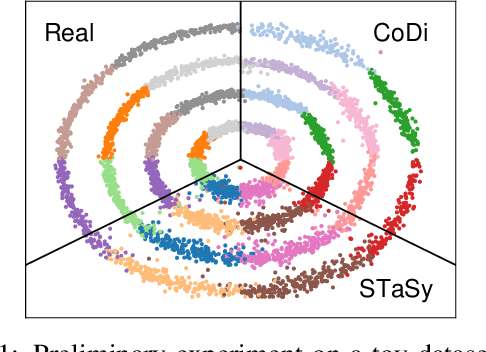
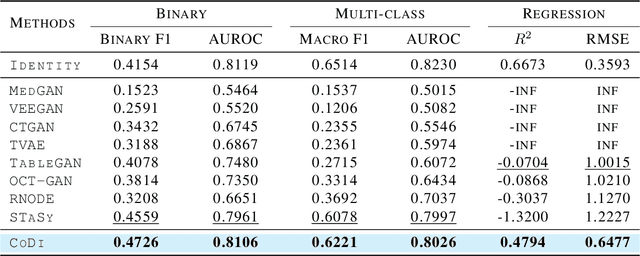
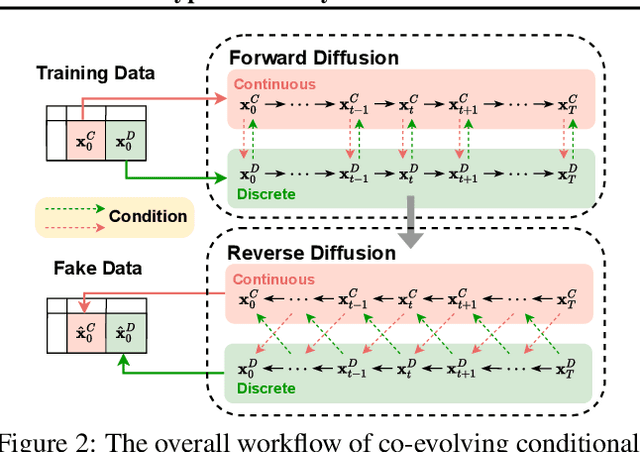
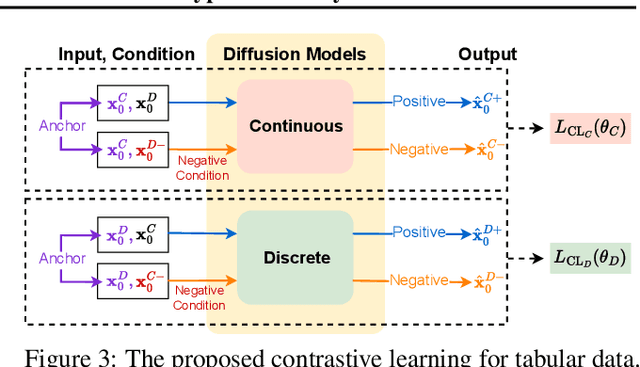
Abstract:With growing attention to tabular data these days, the attempt to apply a synthetic table to various tasks has been expanded toward various scenarios. Owing to the recent advances in generative modeling, fake data generated by tabular data synthesis models become sophisticated and realistic. However, there still exists a difficulty in modeling discrete variables (columns) of tabular data. In this work, we propose to process continuous and discrete variables separately (but being conditioned on each other) by two diffusion models. The two diffusion models are co-evolved during training by reading conditions from each other. In order to further bind the diffusion models, moreover, we introduce a contrastive learning method with a negative sampling method. In our experiments with 11 real-world tabular datasets and 8 baseline methods, we prove the efficacy of the proposed method, called CoDi.
STaSy: Score-based Tabular data Synthesis
Oct 08, 2022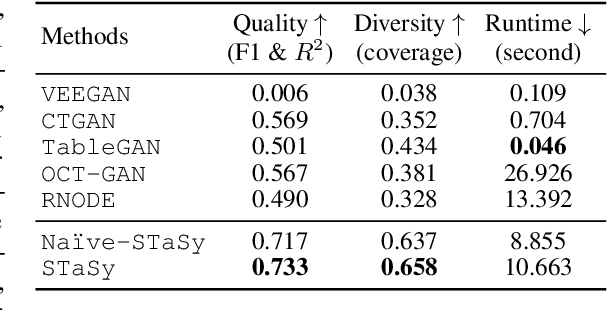
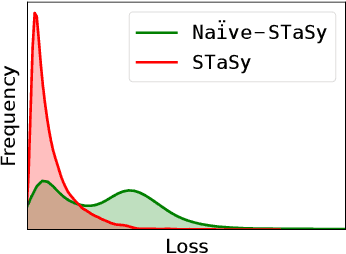
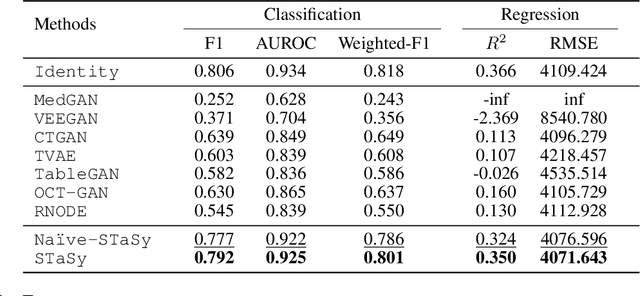

Abstract:Tabular data synthesis is a long-standing research topic in machine learning. Many different methods have been proposed over the past decades, ranging from statistical methods to deep generative methods. However, it has not always been successful due to the complicated nature of real-world tabular data. In this paper, we present a new model named Score-based Tabular data Synthesis (STaSy) and its training strategy based on the paradigm of score-based generative modeling. Despite the fact that score-based generative models have resolved many issues in generative models, there still exists room for improvement in tabular data synthesis. Our proposed training strategy includes a self-paced learning technique and a fine-tuning strategy, which further increases the sampling quality and diversity by stabilizing the denoising score matching training. Furthermore, we also conduct rigorous experimental studies in terms of the generative task trilemma: sampling quality, diversity, and time. In our experiments with 15 benchmark tabular datasets and 7 baselines, our method outperforms existing methods in terms of task-dependant evaluations and diversity.
An Empirical Study on the Membership Inference Attack against Tabular Data Synthesis Models
Aug 25, 2022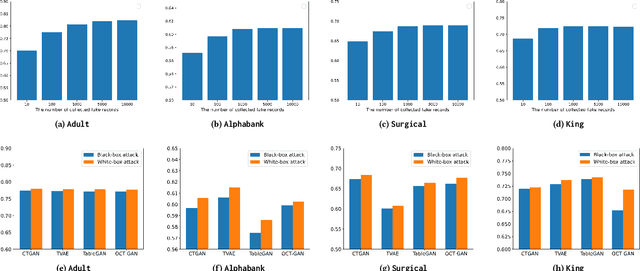



Abstract:Tabular data typically contains private and important information; thus, precautions must be taken before they are shared with others. Although several methods (e.g., differential privacy and k-anonymity) have been proposed to prevent information leakage, in recent years, tabular data synthesis models have become popular because they can well trade-off between data utility and privacy. However, recent research has shown that generative models for image data are susceptible to the membership inference attack, which can determine whether a given record was used to train a victim synthesis model. In this paper, we investigate the membership inference attack in the context of tabular data synthesis. We conduct experiments on 4 state-of-the-art tabular data synthesis models under two attack scenarios (i.e., one black-box and one white-box attack), and find that the membership inference attack can seriously jeopardize these models. We next conduct experiments to evaluate how well two popular differentially-private deep learning training algorithms, DP-SGD and DP-GAN, can protect the models against the attack. Our key finding is that both algorithms can largely alleviate this threat by sacrificing the generation quality.
SOS: Score-based Oversampling for Tabular Data
Jun 17, 2022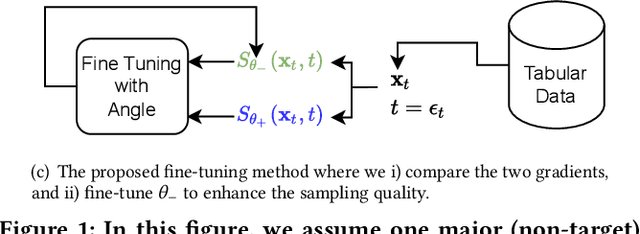
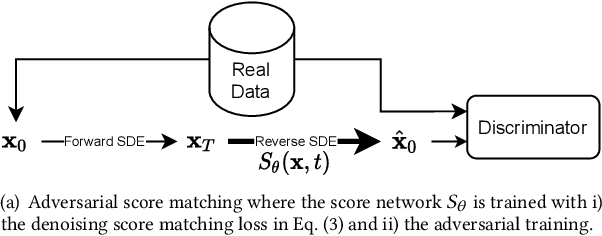
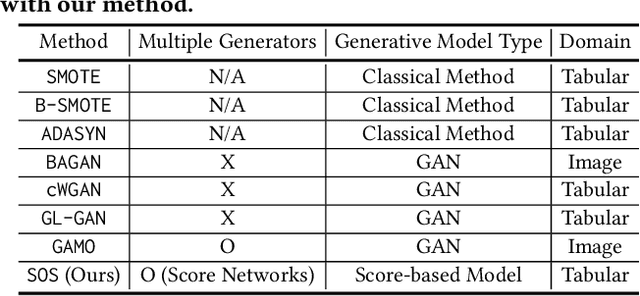
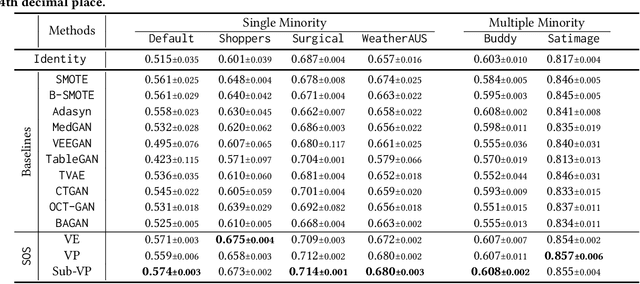
Abstract:Score-based generative models (SGMs) are a recent breakthrough in generating fake images. SGMs are known to surpass other generative models, e.g., generative adversarial networks (GANs) and variational autoencoders (VAEs). Being inspired by their big success, in this work, we fully customize them for generating fake tabular data. In particular, we are interested in oversampling minor classes since imbalanced classes frequently lead to sub-optimal training outcomes. To our knowledge, we are the first presenting a score-based tabular data oversampling method. Firstly, we re-design our own score network since we have to process tabular data. Secondly, we propose two options for our generation method: the former is equivalent to a style transfer for tabular data and the latter uses the standard generative policy of SGMs. Lastly, we define a fine-tuning method, which further enhances the oversampling quality. In our experiments with 6 datasets and 10 baselines, our method outperforms other oversampling methods in all cases.
LORD: Lower-Dimensional Embedding of Log-Signature in Neural Rough Differential Equations
Apr 19, 2022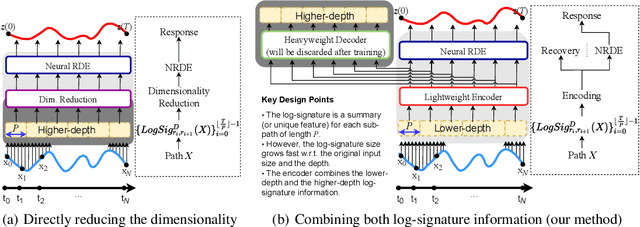

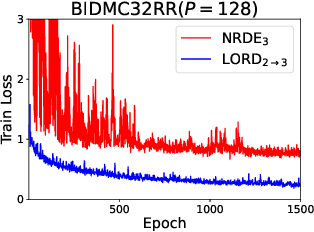

Abstract:The problem of processing very long time-series data (e.g., a length of more than 10,000) is a long-standing research problem in machine learning. Recently, one breakthrough, called neural rough differential equations (NRDEs), has been proposed and has shown that it is able to process such data. Their main concept is to use the log-signature transform, which is known to be more efficient than the Fourier transform for irregular long time-series, to convert a very long time-series sample into a relatively shorter series of feature vectors. However, the log-signature transform causes non-trivial spatial overheads. To this end, we present the method of LOweR-Dimensional embedding of log-signature (LORD), where we define an NRDE-based autoencoder to implant the higher-depth log-signature knowledge into the lower-depth log-signature. We show that the encoder successfully combines the higher-depth and the lower-depth log-signature knowledge, which greatly stabilizes the training process and increases the model accuracy. In our experiments with benchmark datasets, the improvement ratio by our method is up to 75\% in terms of various classification and forecasting evaluation metrics.
EXIT: Extrapolation and Interpolation-based Neural Controlled Differential Equations for Time-series Classification and Forecasting
Apr 19, 2022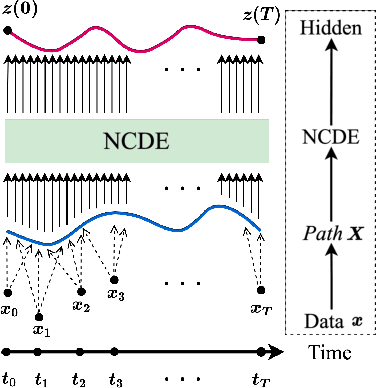
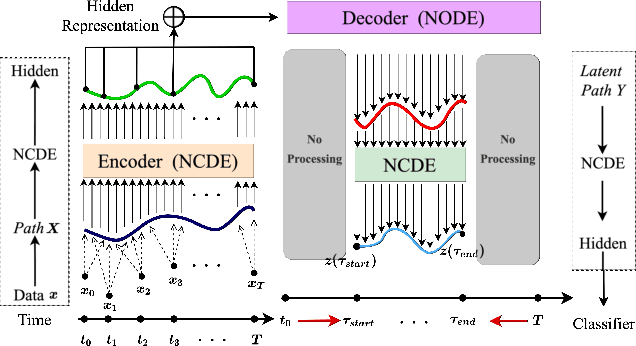
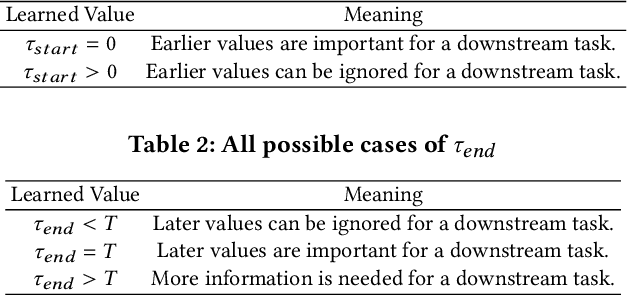

Abstract:Deep learning inspired by differential equations is a recent research trend and has marked the state of the art performance for many machine learning tasks. Among them, time-series modeling with neural controlled differential equations (NCDEs) is considered as a breakthrough. In many cases, NCDE-based models not only provide better accuracy than recurrent neural networks (RNNs) but also make it possible to process irregular time-series. In this work, we enhance NCDEs by redesigning their core part, i.e., generating a continuous path from a discrete time-series input. NCDEs typically use interpolation algorithms to convert discrete time-series samples to continuous paths. However, we propose to i) generate another latent continuous path using an encoder-decoder architecture, which corresponds to the interpolation process of NCDEs, i.e., our neural network-based interpolation vs. the existing explicit interpolation, and ii) exploit the generative characteristic of the decoder, i.e., extrapolation beyond the time domain of original data if needed. Therefore, our NCDE design can use both the interpolated and the extrapolated information for downstream machine learning tasks. In our experiments with 5 real-world datasets and 12 baselines, our extrapolation and interpolation-based NCDEs outperform existing baselines by non-trivial margins.
OCT-GAN: Neural ODE-based Conditional Tabular GANs
May 31, 2021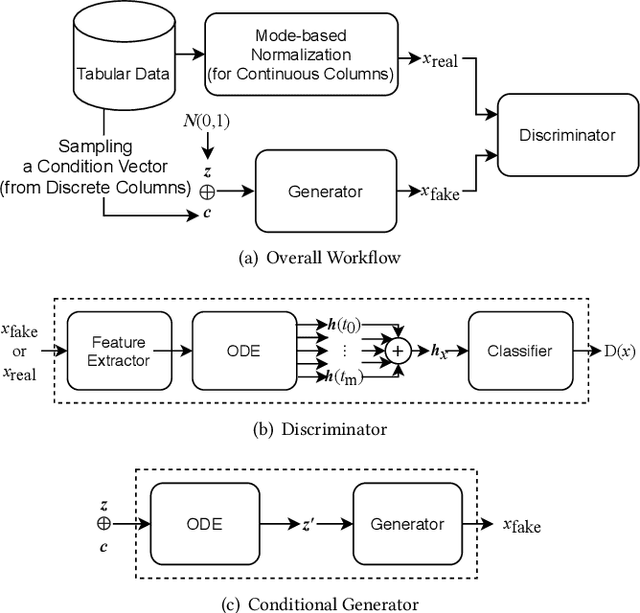

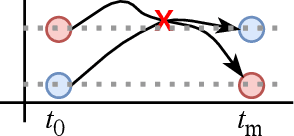

Abstract:Synthesizing tabular data is attracting much attention these days for various purposes. With sophisticate synthetic data, for instance, one can augment its training data. For the past couple of years, tabular data synthesis techniques have been greatly improved. Recent work made progress to address many problems in synthesizing tabular data, such as the imbalanced distribution and multimodality problems. However, the data utility of state-of-the-art methods is not satisfactory yet. In this work, we significantly improve the utility by designing our generator and discriminator based on neural ordinary differential equations (NODEs). After showing that NODEs have theoretically preferred characteristics for generating tabular data, we introduce our designs. The NODE-based discriminator performs a hidden vector evolution trajectory-based classification rather than classifying with a hidden vector at the last layer only. Our generator also adopts an ODE layer at the very beginning of its architecture to transform its initial input vector (i.e., the concatenation of a noisy vector and a condition vector in our case) onto another latent vector space suitable for the generation process. We conduct experiments with 13 datasets, including but not limited to insurance fraud detection, online news article prediction, and so on, and our presented method outperforms other state-of-the-art tabular data synthesis methods in many cases of our classification, regression, and clustering experiments.
 Add to Chrome
Add to Chrome Add to Firefox
Add to Firefox Add to Edge
Add to Edge